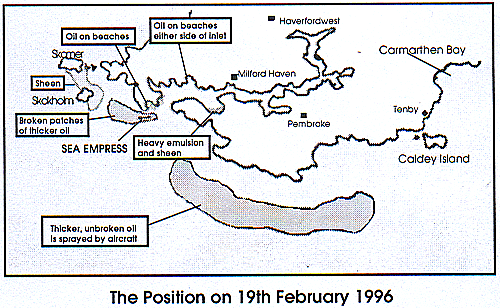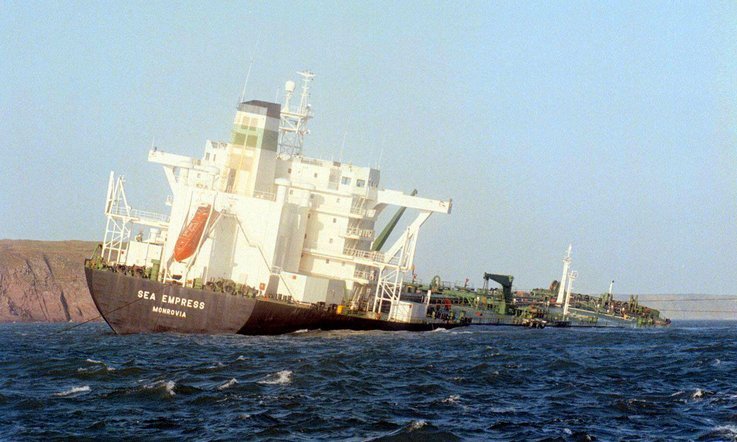What Happened to Cause the Disaster?

The 147,000 tonne oil tanker Sea Empress ran aground on February 15th 1996 at 8.07 pm, despite being under the control of one of Milford Haven’s harbour pilots. Heavy seas had prevented the tanker from being docked earlier, but insufficient safety measures, including the lack of provision for a heavy tug in the area are also being blamed. The fact that it took over 24 hours for a heavy tug, to reach the Sea Empress may well have contributed to the extent of the disaster, as by that time the weather had worsened. Off-loading of the oil still aboard did not start until 24th February.
She was freed from the rocks on which she had been grounded amidships at around 7.10pm on February 21st 1996. A total of twelve tugs were required to pull her free. She was then towed slowly to Milford Haven docks to discharge her remaining cargo (approximately 70,000 tonnes of crude oil) whilst moored to an oil refinery jetty.
The Sea Empress lost around 70,000 tonnes of her cargo of North Sea crude oil. It is comparatively light oil, which gives out its most harmful toxins (poisons) into the water and air within a short time. The rest of the toxins are broken down by micro-organisms in the sea water, but before this crabs, shellfish and fish concentrate toxins within themselves, and some of these concentrated poisons will be far more harmful than the original ones. The toxins are then passed up the food chain.

Credits
Image: Sea Empress photo taken by Barry Batchelor on 16 February 1996.
Information sourced from:
The IUCN Red List of Threatened Species (2015), Melanitta nigra [online], Available from: http://www.iucnredlist.org/details/full/22724879/0 [accessed 05/07/2015]
This fact sheet has been produced using information supplied by:
Friends of the Earth
26-28 Underwood Street
London
N1 7JQ
Tel: 0207 4901 555
The World Conservation Monitoring Centre
219 Huntingdon Road
Cambridge
Sea Mammal Research Unit
High Cross
Madingly Road
Cambridge
CB3 0DL
01223 277871
Institute for Terrestrial Ecology/Countryside Commission for Wales
Plas Pembroke
Ffordd
Penrose
Bangor
LL57 2LQ
01248 370045
What Were the Effects of the Spill?
In West Angle Bay, near Milford Haven, one of only seven colonies nationwide of Green Rockpool starfish was wiped out, and the whole ecosystem was threatened with damage and disruption.
Within a twelve mile radius of the slick are thirteen Sites of Special Scientific Interest (SSSI’s), protected because of their outstanding scientific value. Among these is Skomer Island, a marine reserve owned by the Nature Conservancy Council and home to internationally important colonies of manx shearwater, puffin, lesser black-backed gull, herring gull, great black-backed gull, guillemot, razorbill, storm petrel and shag (over 32,000 birds in total). There is also a large grey seal population.
There are thought to be 85,000 grey seals around Britain’s coast – approximately half the world’s population. Around 5,000 live on the Pembrokeshire coast, and the majority of their breeding sites were affected by the oil spill. Monitoring in the summer of 1997 assessed the impact of the oil spill on the seals and found they had been affected by eating contaminated fish, or by residual oil on their breeding beaches.
Oil lapped Skomer’s shoreline, just 30 metres from the cliffs at Skomer Wick, a nesting site for 14,000 birds. Seabirds need to keep their feathers clean in order to be able to remain buoyant and insulated. Birds can preen oil from their feathers, and in doing so, can ingest poison which kills them within days. It is estimated that between 20,000 and 40,000 seabirds, mainly scoter and guillemots, but also cormorants, red-throated divers, mute swans and razorbills died as a result of the disaster. A strong northerly wind blew the worst of the oil towards Carmarthen Bay and the Bristol Channel, 60km to the south, thus avoiding a greater catastrophe on the bird islands, which are only 10km north of the crash site.
Carmarthen Bay is an important wintering site for up to 10,000 common scoter. Around 600,000 seabirds returned to the Pembrokeshire coast in 1997 from wintering overseas. They may have escaped the direct effects of the oil spill, but damage to the marine ecosystem meant that they were in danger of starvation or breeding failure.
The Sea Empress lost far more of her cargo than the 37,000 tonnes spilled by the Exxon Valdez into Prince William Sound in 1989, killing half a million seabirds and countless fish. Tourism was badly affected, as the Pembrokeshire Coast National Park is usually visited by 500,000 people a year. Many were put off by the thought of oily beaches and polluted seas.

The Clean up Operation
The main containment and dispersal of the oil slick at sea was completed within six weeks. However, the removal of oil on shore took until the late spring of 1997, over a year after the spill. Small amounts of oil were still being found beneath the sand on sheltered beaches and in rock pools in 1999, three whole years after the spill.
Fortunately, the effects of the spill were not as bad as initially predicted. This was partly thanks to the time of year when it occurred. February's stormy weather helped break-up and naturally disperse the oil, and many migratory birds had not yet arrived back from their winter travels. The spill would undoubtedly have been far, far worse, both for wildlife and for the local economy if it had occurred during the later summer months.
Much of the Pembrokeshire coastline recovered relatively quickly. By 2001, the affected marine wildlife population levels had more-or-less returned to normal.
In January 1999, Milford Haven Port Authority (MHPA) was fined four million pounds after pleading guilty to the offence of causing pollution under the Water Resources Act of 1991. They also had to pay a further £825,000 in costs. The cost of the clean-up operation was estimated to be £60m. When the effects to the economy and environment are taken into account, the final cost is estimated to have been twice that.




